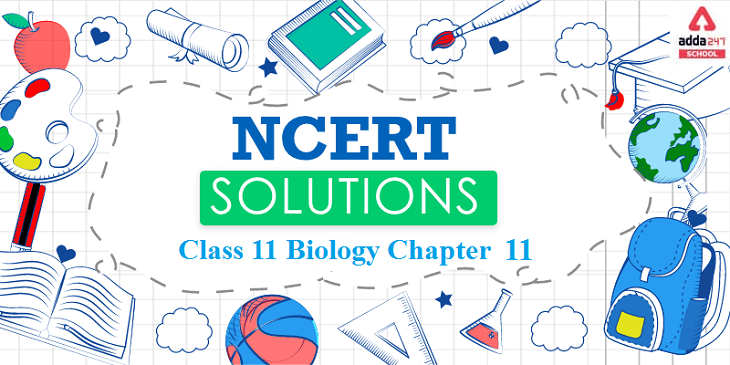Ncert Solutions For Class 11 Biology Chapter 11 in English
Adda 247 provides NCERT Solutions for Class 11 Biology Chapter 11 which is for the students who want to go ahead in life and achieve great marks in their examinations. The NCERT Solutions for class 11 Biology Chapter 11 are provided by the teachers who are experts in their subjects. The solutions are set according to the rules formulated by the NCERT class 11 biology and in the language that can be understood by every student. By these reading, the solutions students can build up a strong base easily. The NCERT class 11 Biology solutions cover chapters 1 to 22 with the important questions and the answers in a detailed way.
Examinations can be threatening for some people, a proper learning of the concepts is the key to crack the examination. Students rely on the solutions of the NCERT provided by Adda 247. The solutions are formulated by the experts of the subjects who have tremendous knowledge in their subjects.
These NCERT Solutions of class 11 help the students to get familiarized with the textbooks. The students can access the solutions anywhere while browsing the web easily. The solutions are very precise and accurate.
NCERT Solutions for Class 11 Biology Chapter 11 – Transport in Plants
The chapter provides information about Transport in Plants. In flowering plants, a complex movement of materials take place in different directions. This is despite the fact that plants do not bear any circulatory system. Water taken up by the roots has to reach all the parts of the plant, up to very tip of the growing stem, where photosynthesis and growth are going on. Leaves manufacture food, which has to be supplied to all parts of the plant including the roots.
Materials also move over short distances, i.e., inside the cell, across the membranes or even cell to cell. The substances transported are water, mineral, nutrients, organic nutrients and plant growth regulators. Over short distances the substances move by diffusion and cytoplasmic streaming supplemented by active transport while, the long distance transport takes place through xylem and phloem and is called translocation.
[sso_enhancement_lead_form_manual title=”Download Full PDF of Class 11 Biology Chapter 11 ” button =”Download Now” pdf =”/jobs/wp-content/uploads/2021/06/16132432/English-chapter-11.pdf”]
Features of the NCERT Solutions for Class 11 Biology Chapter 11- Transport in Plants
NCERT Solutions of class 11 have been answered based on the important information on the question.
- The columns are used wherever necessary.
- Solutions are solved point wise and accurately answered point to point.
NCERT Solutions for Class 11 Biology Chapter 11: Important Questions
Question 1. What are the factors affecting the rate of diffusion?
Concentration: Diffusion of molecules is entirely dependent on moving from an area of higher concentration to an area of lower concentration. In other words, diffusion occurs down the concentration gradient of the molecule in question. If the difference in concentration is higher, then the molecules will go down the concentration gradient faster. If there is not as great of a difference in concentration, the molecules will not move as quickly and the rate of diffusion will decrease.
Temperature: Particles move due to the kinetic energy associated with them. As temperature increases, the kinetic energy associated with each particle also increases. As a result, particles will move faster. If they can move faster, then they can also diffuse faster. Conversely, when the kinetic energy associated with the molecules decreases so does their movement. As a result, the rate of diffusion will be slower.
Mass of Particle: Heavier particles will move more slowly and so will have a slower rate of diffusion. Smaller particles on the other hand will diffuse faster because they can move faster. As is key with all factors affecting diffusion, movement of the particle is paramount in determining if diffusion is slowed down or sped up.
Solvent Properties: Viscosity and density greatly affect diffusion. If the medium that a given particle has to diffuse through is very dense or viscous, then the particle will have a harder time diffusing through it. So the rate of diffusion will be lower. If the medium is less dense or less viscous, then the particles will be able to move more quickly and will diffuse faster.
Question 2. What are porins? What role do they play in diffusion?
Answer: Porins are special proteins having large pores and are present in the outer membrane of the plastids, mitochondria and bacteria. They allow molecules to pass upto size of the small proteins. They help in movement of molecules and in facilitated diffusion.
Question 3. Describe the role played by protein pumps during active transport in plants.
Answer: In plant cells, protein pumps are used to transport the substances against the concentration
gradient, i.e., from a region of lower concentration to a region of higher concentration. Each protein
pump is very specific in what substance it carries across the membrane. The protein pumps are made up
of specific proteins called trans-membrane proteins. These specific proteins make a complex with the
substance to be transported across the membrane, using the energy derived from ATP. On entering the
cytoplasm, this protein–substance complex gets dissociated to liberate the substance
Question 4. Explain why pure water has the maximum water potential.
Answer: Water potential quantifies the tendency of water to move from one part to the other during various cellular processes. It is denoted by the Greek letter Psi or Ψ. The water potential of pure water is always taken as zero at standard temperature and pressure.
It can be explained in terms of the kinetic energy possessed by water molecules. When water is in liquid form, the movement of its molecules is rapid and constant. Pure water has the highest concentration of water molecules. Therefore, it has the highest water potential. When some solute is dissolved in water, the water potential of pure water decreases.
Question 5. Differentiate between the following: (a) Diffusion and Osmosis
(b) Transpiration and Evaporation
(c) Osmotic Pressure and Osmotic Potential
(d) Imbibition and Diffusion
(e) Apoplast and Symplast pathways of movement of water in plants
(f) Guttation and Transpiration
Answer:
(a) Diffusion and osmosis
| Diffusion | Osmosis |
| It is the passive movement of particles, ions, and molecules along the concentration gradient. | It is the process of diffusion of a solvent through a semi permeable membrane.
|
| It takes place in solids, liquids and gases. | It occurs in liquids only. |
| It does not require semi permeable membrane. | It requires semi permeable membrane. |
(b) Transpiration and evaporation
| Transpiration | Evaporation |
| It occurs in plants. | It occurs from any free surface and includes living and non-living surfaces. |
| It is a physiological process. | It is a physical process. |
| It occurs through stomatal pores on the leaves. | It occurs through any free surface. |
| It is controlled by environmental factors such as root-shoot ratio and number of stomata. | It is driven by environmental factors. |
(c) Osmotic pressure and osmotic potential
| Osmotic pressure | Osmotic potential |
| It is expressed in bars with a positive sign.
|
It is expressed in bars with a negative sign. |
| It is a positive pressure. | It is a negative pressure. |
| Its value increases with an increase in the concentration of solute particles. | Its value decreases with an increase in concentration of solute particles. |
(d) Imbibition and Diffusion
| Imbibition | Diffusion |
| It is a special type of diffusion where water is absorbed by solids and colloids, causing an enormous increase in volume. | It is the passive movement of particles, ions, molecules along the concentration gradient. |
| It involves water. | It involves solids, liquids and gases. |
(e)Apoplast and symplast pathway
| Apoplast pathway | Symplast pathway |
| It involves the movement of water through the adjacent cell walls of the epidermis and cortex. The movement of water is restricted at the casparian strips of the root endodermis. | It involves the movement of water through the interconnected protoplasts of the epidermis, cortex, endodermis and root pericycle. |
| It is a faster process. | It is a slower process. |
(f) Guttation and transpiration
| Guttation | Transpiration |
| Occurs at night | Occurs during the day |
| Water is lost from the leaves in the form of liquid droplets. | Water is lost in the form of water vapour. |
| It occurs through vein endings of leaves. | It occurs through stomata. |
| It is an uncontrolled process. | It is a controlled process. |
Question 6. Briefly describe water potential. What are the factors affecting it?
Answer: Water potential is the quantitative measure of water to move from one part of the plant to the other part during various cellular processes such as diffusion, osmosis, etc. It is denoted by the Greek letter Psi or and is expressed in Pascals (Pa). Water pressure of pure water is taken as zero at standard temperature and pressure. A solution has less water potential due to less water concentration. Water potential of a cell is affected by solute and pressure potential.
Solute potential- The magnitude of lowering of water potential due to the dissolution of solute is called solute potential.
Solute potential- The magnitude of lowering of water potential due to the dissolution of solute is called solute potential.
Pressure potential- The water potential of pure water or a solution increases on the application of pressure values more than atmospheric pressure. It is termed as pressure potential.
The relation between water potential and pressure potential is as follows:
Question 7. What happens when a pressure greater than the atmospheric pressure is applied to pure water or a solution?
Answer: The water potential of pure water or a solution increases on the application of pressure values more than atmospheric pressure. For example, when water diffuses into a plant cell, it causes pressure to build up against the cell wall. This makes cell wall turgid. The pressure is known as pressure potential and has a positive value.
Question 9. How is the mycorrhizal association helpful in absorption of water and minerals in plants?
Answer: Mycorrhiza is the symbiotic association between roots of some plants and fungi. The hyphae provide a very large surface area and absorb mineral ions and water from soil. This is not possible for roots. The fungi provides mineral and water to roots. The hyphae secrete chemicals which protect the roots from pathogens.
Question 10. What role does root pressure play in water movement in plants?
Answer: Root pressure is the positive pressure that develops in the roots of plants by the active absorption of nutrients from the soil. When the nutrients are actively absorbed by root hairs, water (along with minerals) increases the pressure in the xylem. This pressure pushes the water up to small heights. Root pressure can be observed experimentally by cutting the stem of a well-watered plant on a humid day. When the stem is cut, the solution oozes from the cut end.
Root pressure is also linked to the phenomenon of guttation, i.e., the loss of water in the form of liquid droplets from the vein endings of certain herbaceous plants.
Root pressure is only able to transport water up to small heights. However, it helps in re-establishing the continuous chains of water molecules in the xylem. Transpirational pull maintains the flow of water molecules from the roots to the shoots.
Question 11. Describe transpiration pull model of water transport in plants. What are the factors influencing transpiration? How is it useful to plants?
Answer: Transpiration is the evaporative loss of water by plants. It occurs mainly through the stomata in the leaves. Exchange of oxygen and carbon dioxide in the leaf also occurs through stomata. Normally stomata are open in the day time and close during the night. The cause is a change in the turgidity of the guard cells. The inner wall of each guard cell towards the stomatal aperture is thick and elastic. When turgidity increases, the thin outer walls bulge out and force the inner walls into a crescent shape. The opening of stoma is also aided due to the orientation of the microfibrils in the cell walls of the guard cells.
Factors affecting Transpiration: Temperature, light, humidity and wind speed.
Importance of Transpiration: Transport of liquids and minerals is facilitated because of transpiration.









 CBSE Date Sheet 2026 for Class 10 & ...
CBSE Date Sheet 2026 for Class 10 & ...
 CUET History Syllabus 2026 (Updated), Do...
CUET History Syllabus 2026 (Updated), Do...
 CUET General Test Syllabus 2026 (Latest)...
CUET General Test Syllabus 2026 (Latest)...














